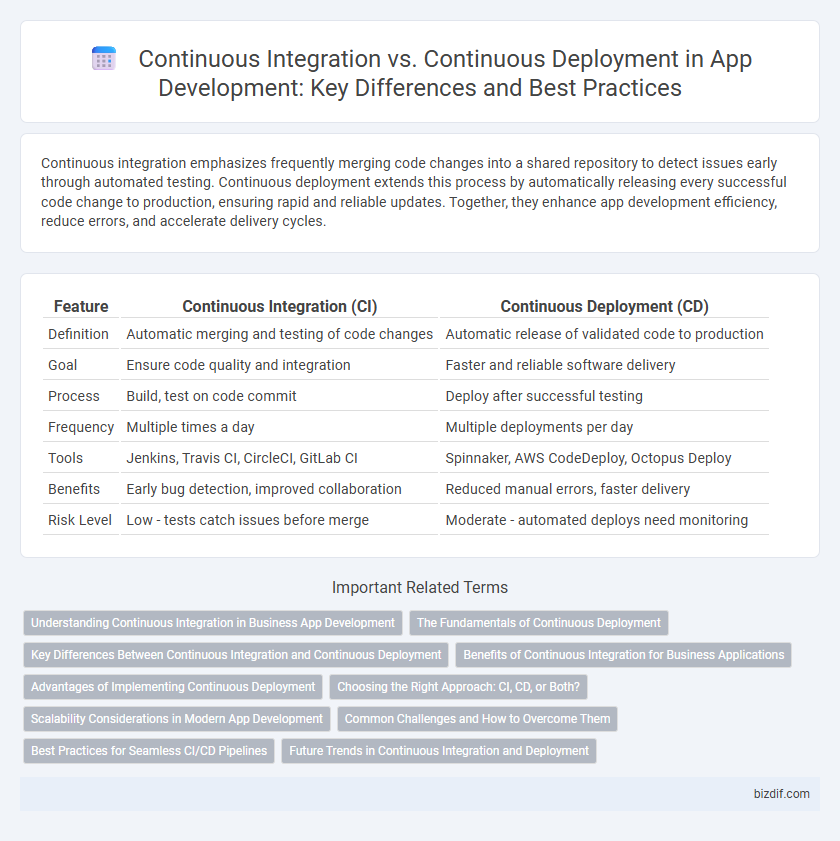Continuous integration emphasizes frequently merging code changes into a shared repository to detect issues early through automated testing. Continuous deployment extends this process by automatically releasing every successful code change to production, ensuring rapid and reliable updates. Together, they enhance app development efficiency, reduce errors, and accelerate delivery cycles.
Table of Comparison
| Feature | Continuous Integration (CI) | Continuous Deployment (CD) |
|---|---|---|
| Definition | Automatic merging and testing of code changes | Automatic release of validated code to production |
| Goal | Ensure code quality and integration | Faster and reliable software delivery |
| Process | Build, test on code commit | Deploy after successful testing |
| Frequency | Multiple times a day | Multiple deployments per day |
| Tools | Jenkins, Travis CI, CircleCI, GitLab CI | Spinnaker, AWS CodeDeploy, Octopus Deploy |
| Benefits | Early bug detection, improved collaboration | Reduced manual errors, faster delivery |
| Risk Level | Low - tests catch issues before merge | Moderate - automated deploys need monitoring |
Understanding Continuous Integration in Business App Development
Continuous Integration (CI) in business app development automates code merging and testing to identify defects early, improving software quality and reducing integration issues. CI enables development teams to frequently commit code changes into a shared repository, triggering automated builds and tests that maintain application stability. Implementing CI accelerates release cycles, enhances collaboration, and supports scalable, reliable business applications with faster feedback loops.
The Fundamentals of Continuous Deployment
Continuous deployment automates the release process by deploying every code change that passes automated testing directly to production, ensuring rapid delivery and minimizing manual intervention. It relies on a robust continuous integration pipeline that includes rigorous automated testing, monitoring, and rollback mechanisms to maintain system stability. This fundamental approach accelerates feedback loops, improves software quality, and enhances the overall efficiency of app development workflows.
Key Differences Between Continuous Integration and Continuous Deployment
Continuous Integration (CI) involves automatically merging code changes into a shared repository multiple times a day, ensuring early detection of integration issues through automated testing. Continuous Deployment (CD) extends CI by automatically releasing every validated change to production, enabling faster delivery and reducing manual intervention. The key differences lie in CI focusing on code integration and testing, while CD encompasses automated deployment, accelerating the entire software release cycle.
Benefits of Continuous Integration for Business Applications
Continuous Integration (CI) enhances business applications by enabling faster detection and resolution of coding errors, reducing integration problems, and improving software quality. By automating the build and testing processes, CI ensures consistent and reliable code updates, which accelerates delivery cycles and minimizes downtime. This approach fosters collaborative development, increases team productivity, and supports scalable, agile business operations.
Advantages of Implementing Continuous Deployment
Continuous Deployment accelerates the software release process by automatically deploying code changes to production, reducing manual intervention and errors. It enhances developer productivity and customer satisfaction by delivering features and fixes rapidly and consistently. Continuous Deployment supports faster feedback loops and continuous improvement, enabling teams to respond swiftly to market demands and user needs.
Choosing the Right Approach: CI, CD, or Both?
Selecting between Continuous Integration (CI) and Continuous Deployment (CD) depends on the project's complexity and release frequency; CI emphasizes automated testing and code integration, ensuring code quality before merging, while CD automates the release process, enabling rapid and reliable software delivery. Many organizations implement both CI and CD together to streamline development cycles, reduce manual errors, and accelerate time-to-market for mobile and web applications. Evaluating team expertise, infrastructure capabilities, and business goals is essential to adopting an effective CI/CD pipeline that balances speed and stability in app development.
Scalability Considerations in Modern App Development
Scalability considerations in modern app development prioritize Continuous Integration (CI) for ensuring consistent, automated testing and merging of code changes, which supports rapid scaling without compromising quality. Continuous Deployment (CD) streamlines the release process by automatically pushing code changes to production, enabling faster user feedback and iterative improvements, essential for handling fluctuating workloads. Combining CI/CD pipelines enhances scalability by maintaining code stability and accelerating delivery, crucial for adapting to growing user demands and dynamic application environments.
Common Challenges and How to Overcome Them
Common challenges in continuous integration (CI) and continuous deployment (CD) include integration conflicts, high latency in automated tests, and deployment failures due to environment inconsistencies. Overcoming these issues requires adopting robust version control practices, optimizing test automation for faster feedback, and using containerization tools like Docker to ensure environment parity. Implementing feature toggles and gradual rollout strategies can further minimize risk and improve stability during deployments.
Best Practices for Seamless CI/CD Pipelines
Implement version control systems like Git to maintain code integrity and enable automated testing at every commit, ensuring rapid detection of defects. Integrate automated build and test processes within the CI/CD pipeline to maintain a consistent deployment rhythm and minimize manual errors. Employ feature toggles and rollbacks in continuous deployment to safely release new code and swiftly address any production issues without disrupting end-user experience.
Future Trends in Continuous Integration and Deployment
Future trends in Continuous Integration (CI) and Continuous Deployment (CD) emphasize AI-driven automation to enhance build accuracy and reduce human errors. Cloud-native technologies and containerization support scalable, real-time pipeline orchestration enabling faster release cycles. Enhanced security integration within CI/CD workflows addresses increasing cyber threats, ensuring safer app development and deployment processes.
Continuous integration vs Continuous deployment Infographic

 bizdif.com
bizdif.com